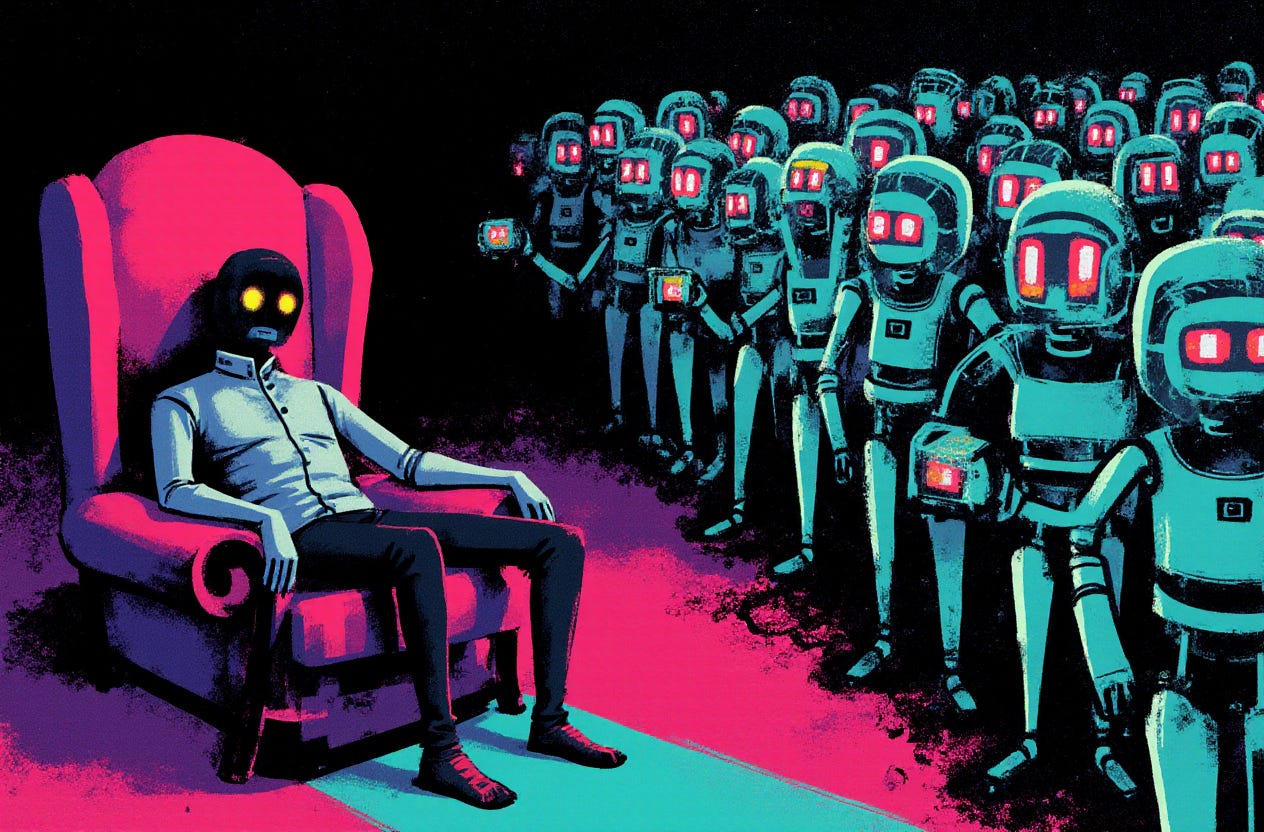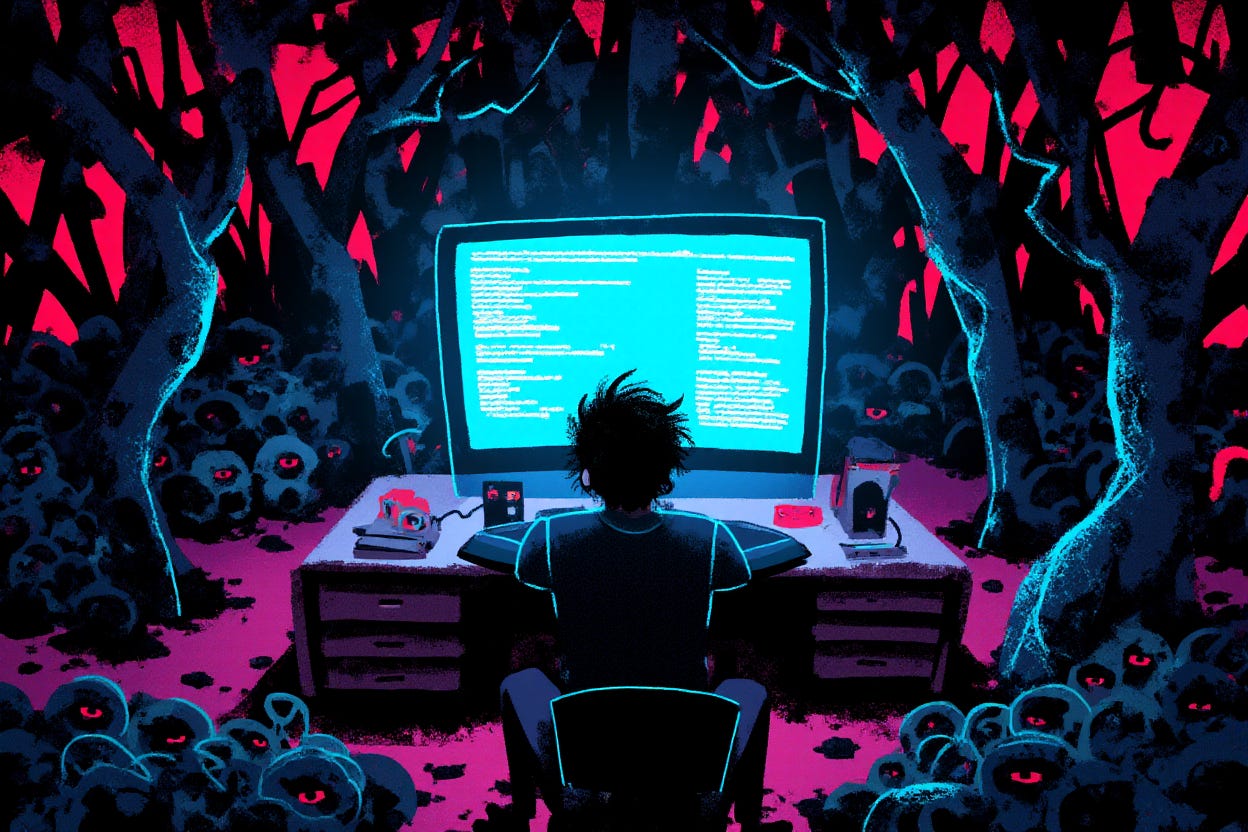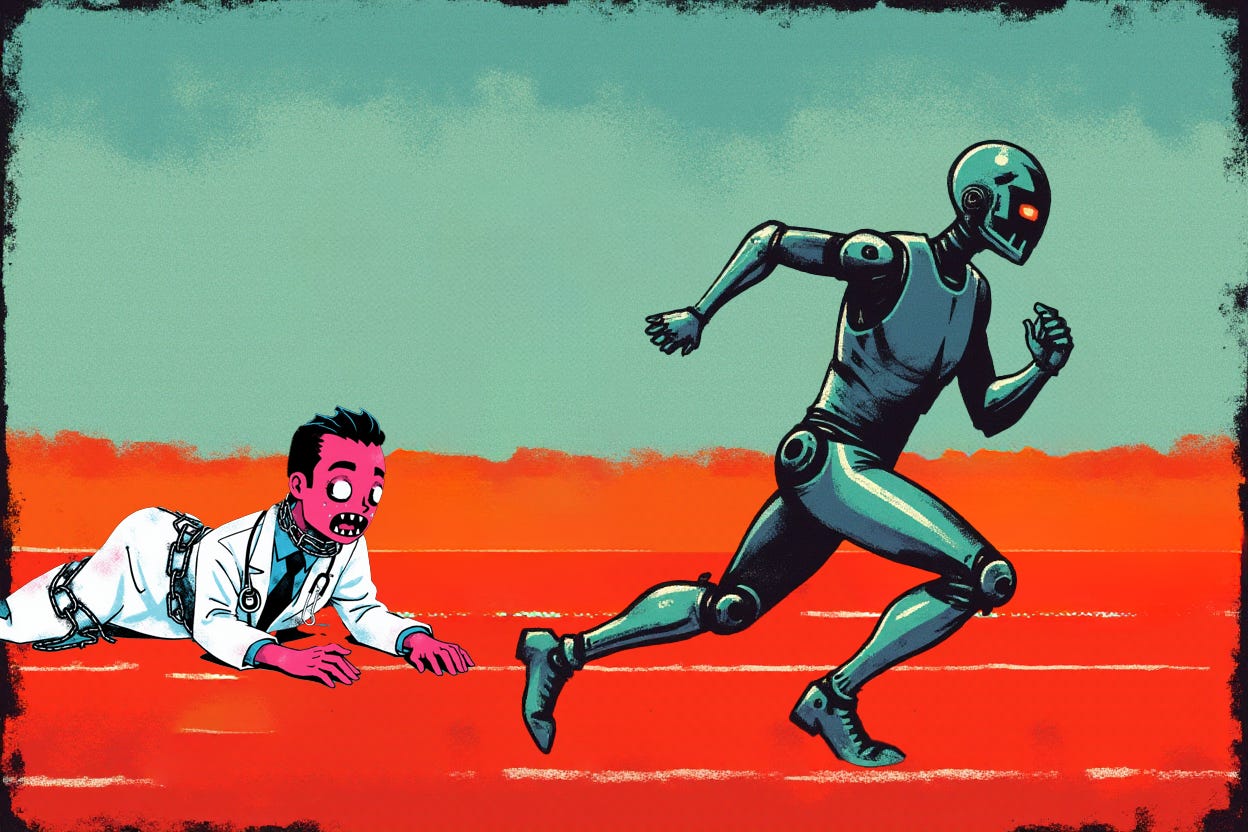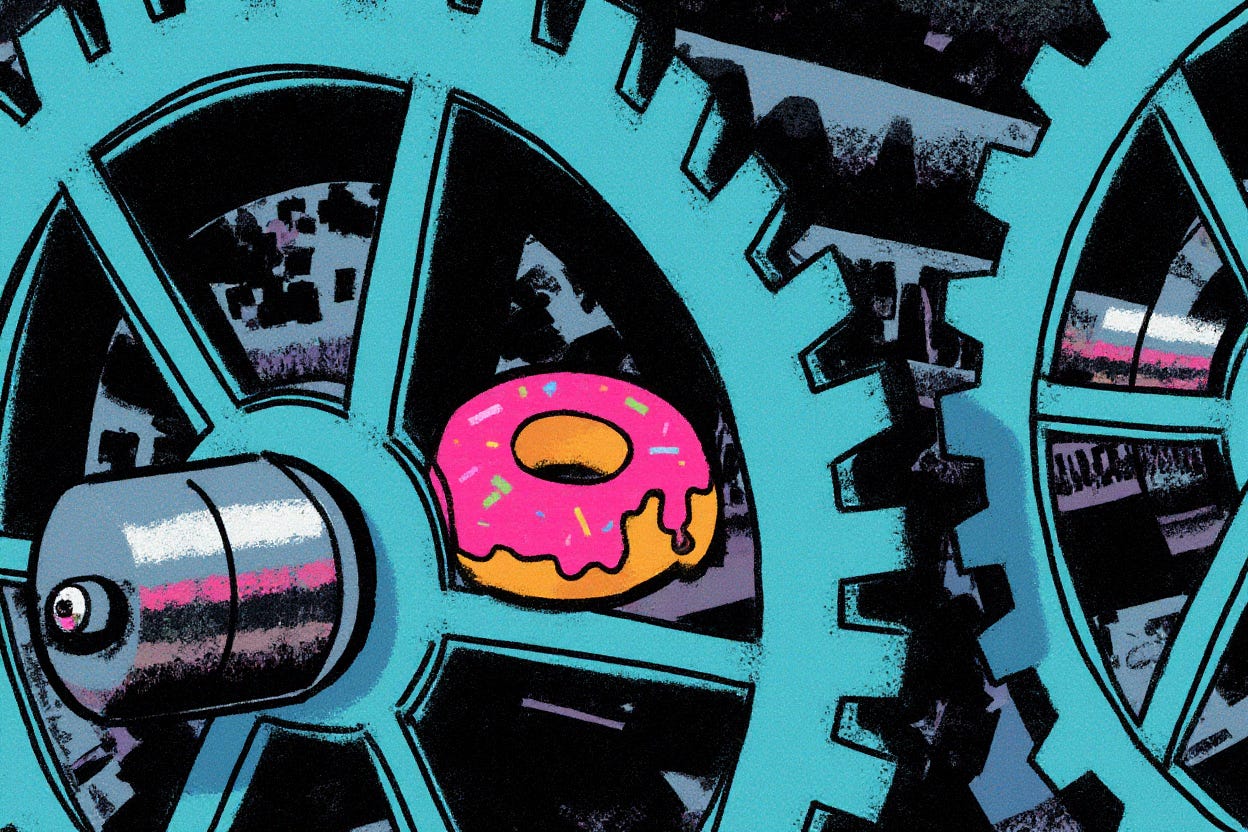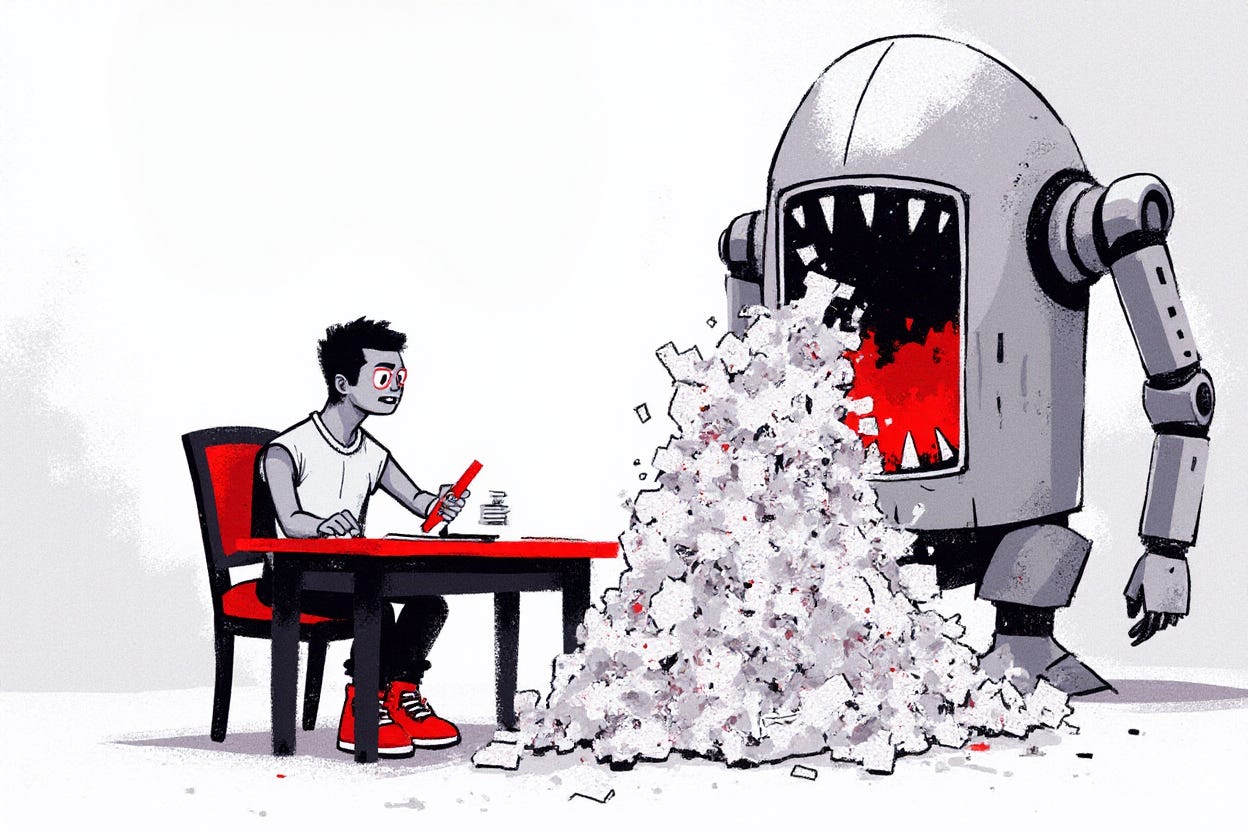The 99% of Your Job That AI Can't Do
Why the Coder's Fallacy and the AI Job Apocalypse are a Nerd Fantasy
Spend five minutes on any tech forum or social media platform, and you’ll find yourself in the middle of a Category 5 hurricane of AI predictions. On one side, you have the doomers, wringing their hands about imminent, mass unemployment as intelligent machines render humanity obsolete. On the other, you have the hypers, fantasizing about a post-work utopia of fully automated luxury gay space communism, or, more cynically, planning how they’ll get rich using AI to replace everyone else. But for all their differences, the doomers and the hypers all stand together on one piece of bedrock certainty: widespread, wholesale job automation is not a question of if, but when.
The "How, Specifically?" Gauntlet
This dynamic was perfectly captured in a recent online discussion. Someone asked a simple, honest question: “It’s funny that people say AI will take over jobs, but how specifically?” Another person jumped in with supreme confidence: “Actually, we don't really need to guess anymore—we're watching it unfold.” This is where I stepped in. “Okay,” I replied, “if we don't have to guess, then how, specifically? It's important to be precise. We see lots of vague assertions, but not a lot of actually walking it out.” The response was a deafening silence, followed by a flurry of vague assertions, goalpost-shifting, and even one person telling me to just “ask the AI how it’s going to replace everyone.”
The entire, massive discourse about AI-driven job replacement seems to be floating on a cloud of confident, sweeping statements that instantly evaporate under the pressure of one simple question: “How, specifically?” Proponents can talk for hours about exponential curves and the next generation of models, but they can’t seem to walk you through the mundane, real-world, end-to-end process of actually replacing, say, an accountant or an auditor.
This isn’t a theoretical debate for me. I’m not some Luddite pundit throwing rocks from the sidelines.
I teach graduate students about AI at a private university. I’m building software for AI-augmented knowledge work. I run workshops teaching white-collar professionals how to integrate these tools into their jobs right now. My skepticism about wholesale job replacement doesn’t come from a fear of the technology; it comes from the daily, frustrating, and often hilarious reality of trying to make it work.
So, in this post, we’re going to do what the pundits won’t. We’re going to answer the “how, specifically?” question. We’re going to walk through, step-by-step, why the popular narrative of AI job automation is a fantasy, built on a fundamental misunderstanding of work, intelligence, and reality itself. We’re going to debunk the foundational axioms that so many people take for granted. Let's start by looking at who is making these predictions, and why their worldview is so dangerously flawed.
The Prophet's Blind Spot: "My Job is Safe, Yours is Simple"
Here’s a fascinating quirk of the human brain that explains almost everything about the AI job panic. A recent YouGov poll asked Americans about AI's impact on 20 different occupations, from lawyers to truck drivers. For every single one, the dominant view was that AI would slash the number of jobs. Widespread carnage. But then the pollsters asked people about the industry where they work. Suddenly, the panic vanished. A huge plurality (42%) said they expected no effect at all, and the number predicting a decrease was cut nearly in half.
This isn't hypocrisy; it's a paradox born of expertise. You know your own job. You know about the weird client who only communicates in riddles, the supply closet that's always jammed, the impossible-to-predict traffic on your service route, and the thousand other messy, unwritten, deeply human things you navigate every single day. You intuitively understand that no chatbot is remotely close to handling that reality. But when you look at someone else's job from the outside? It looks simple. It’s an abstraction, a clean list of tasks on a job description. You suffer from domain ignorance, and that ignorance makes automation look easy.
This cognitive bias is universal, but it becomes a society-bending problem when one specific group’s domain ignorance starts driving the entire public conversation. And right now, the loudest prophets of the AI jobpocalypse are a very particular demographic: young, disproportionately male, extremely online, and almost entirely employed in software development. They are brilliant in their narrow domain, but many have limited experience with the vast, messy, non-digitized world of work that most people inhabit.
And this leads them to a dangerous mental trap I call The Coder's Fallacy. It’s a simple, elegant, and catastrophically wrong piece of logic that goes like this:
Premise 1: My job (software engineering) is one of the most intellectually demanding, high-IQ jobs a human can do.
Premise 2: I am watching AI get remarkably good at doing my job, writing and debugging code in real-time.
Conclusion: Therefore, if AI can do my complex job, it must be on the verge of doing all the “simpler” jobs that I, a high-IQ person, could easily do.
It’s a compelling syllogism, but it’s built on a spectacular failure of imagination. The problem isn’t their logic; it's that they are fundamentally miscalibrated on the nature of difficulty itself. We humans are dazzled when an AI does something we find hard, and we completely ignore the vast mountain of tasks we find trivial. We see an AI write flawless code and we think, “Wow, that’s genius-level work!” because tracking complex logical dependencies is exhausting for our brains. We’re like a fish impressed by a bird's ability to fly, while taking our own ability to breathe water completely for granted.
The truth is, the tasks that require immense human effort—perfect recall, lightning-fast calculation, flawless logical operations—are the native language of a computer. Meanwhile, the skills we find so effortless we don’t even call them “skills”—sensing a shift in a client's mood, navigating a cluttered storeroom, distinguishing sarcasm from sincerity—are, for a machine, computational nightmares of near-infinite complexity. The Coder’s Fallacy isn’t just a flawed argument; it’s a failure to realize we’ve been measuring intelligence with the wrong ruler.
The Great Inversion: Why Software Engineering is a "Low-IQ" Job for an AI
This brings us to the beautiful, delicious irony at the heart of this whole panic. Once you start measuring with the right ruler—a machine's ruler, not a human's—you see why the Coder's Fallacy is so catastrophically wrong. The young programmer looks at his job, sees its intellectual demands, and assumes it must be the final peak for an AI to conquer. The truth is the exact opposite. From a machine's perspective, software engineering isn't the final boss. It's the tutorial level.
When you want to know a job's true potential for automation, you have to stop thinking like a human and start thinking like a machine. I would argue there are two simple questions that matter more than anything else:
Does the job have an objective, measurable, and clear definition of success?
Is the entire body of knowledge required to perform the job already 100% digitized and accessible to an AI?
Now, let’s run software engineering through that test. Does it have a clear definition of success? A resounding "Yes!" Does the code compile? Does it pass the predefined tests? Does it execute without throwing an error? These are not matters of opinion; they are brutally binary. Is the knowledge base digitized? Absolutely. Decades of every programming language, every library, every question on Stack Overflow, and every public repository on GitHub form the most perfect, comprehensive, text-based training corpus an AI could ever dream of.
Software engineering passes both tests with flying colors. It is, quite simply, the ideal job for an LLM to learn. The very things that make coding hard for humans—the need for flawless syntax, the management of complex logical systems, the memorization of endless commands—are the things that are utterly trivial for a machine. It's a job that takes place entirely inside the computer's own world, a closed system of logic and text with clear rules. It is the definition of a low-context profession.
This is why it’s so absurd to use coding as a benchmark for AI's ability to do other jobs. If I were to rank professions by the "Machine IQ" required to fully automate them, the list would start with the easiest: Tier 1 customer service, which is almost entirely scripted. And what would be number two? Software engineering. In fact, I’d make an even more provocative claim: Being a good Reddit moderator requires a higher-IQ AI than being a senior software engineer. A moderator has to interpret sarcasm, understand rapidly shifting social norms, detect subtle trolling, and intuit user intent from ambiguous language. It is a messy, high-context, deeply human job. A software engineer, by comparison, is just a very complicated calculator.
The coders aren't wrong when they see AI coming for their jobs. They're just wrong to think their job is special. They are the canaries in the coal mine, not because their work is the most complex, but because it is the most perfectly suited for automation by the tools they themselves are building. They have mistaken their own reflection for a picture of the entire world.
This brings us back to that second, crucial question: Is the entire body of knowledge required to perform a job already 100% digitized? For a software engineer, the answer is a resounding "yes." But for almost everyone else, the answer is a resounding "no," because most of the knowledge required for a job exists outside of a computer entirely. To understand this gap, we need to run a simple thought experiment.
A savvy reader might correctly point out that I’m painting with a broad brush here, and that not all "coding" is created equal. I'm primarily talking about backend engineering—the world of pure logic, databases, and APIs. Frontend and UX/UI design is a different animal entirely, demanding nuanced aesthetic judgment and an intuitive grasp of human psychology. The delicious irony, which I plan to explore in my next post, is watching backend developers—whose own jobs are perfectly structured for AI—confidently declare that the "softer," more subjective work of their frontend colleagues is just a prompt away from obsolescence. It's the Coder's Fallacy all the way down.
The Einstein in the Room: Why Context is King
Albert Einstein, by most accounts, was a reasonably intelligent guy. Let's say you could time-travel him from 1945 directly into the room with you right now. He appears, disoriented but unharmed. You look him in the eye and give him one, simple instruction: "Write me an email."
Could he do it? Of course not. And it has absolutely nothing to do with his staggering intellect. His failure would be total and immediate. He wouldn't know what an "email" is. He wouldn't know what a computer is, or a keyboard, or a mouse. He wouldn't understand the implicit social etiquette of a subject line, a greeting, or a sign-off. He lacks every single shred of the necessary context. No amount of raw processing power, no genius-level IQ, can overcome a complete context deficit. Intelligence is useless in a vacuum.
Now, the knee-jerk response from the tech-optimist is obvious: "So? Just teach him! Give him a 30-minute tutorial on email. Problem solved!" And they are absolutely right. The reason I chose the email example is precisely because its context is so trivial to provide. It's a simple, fully-digitized task that perfectly illustrates the distinction: raw intelligence and context availability are two completely separate problems.
The real question isn't whether a genius can learn a new skill. The real question is: Do we possess a high-fidelity, complete, digitized record of all the necessary context for most human jobs? And if we don't, are we even capable of creating one?
For the accountant untangling a shoebox of faded receipts, or the manager sensing tension in a meeting, the answer is a resounding "No." This is where the problem becomes nearly insurmountable, not just because of the volume of context, but because we humans are fundamentally unreliable narrators of our own expertise. A huge portion of what we call "judgment" or "intuition" is our System 1 brain running a massively parallel process on a lifetime of sensory and social data. When asked why we made a decision, our conscious System 2 brain doesn't have access to that raw process. So, it does what it does best: it confabulates. It creates a neat, logical, post-hoc rationalization that sounds good but often has little to do with the real reason.
We think we're explaining our reasoning, but we're actually just telling a plausible story.
This is, ironically, the exact same behavior we see in AI. When you ask an LLM to explain a bizarre mistake, it doesn't admit its probabilistic process failed. It confabulates, generating a plausible-sounding but completely fabricated chain of 'reasoning.' In trying to build a machine that thinks, we may have accidentally created the ultimate System 2 rationalizer—a perfect mimic of our own self-deception.
This is a disaster for AI training. We would feed an AI a library of our "best practices" and "decision-making frameworks," which are often just the sanitized, fictional accounts of our real, messy, intuitive thought processes. We would be, in effect, meticulously training the AI on our own self-deceptions. Then we'd be baffled when the AI, trained on these lies, fails to replicate our success. The problem isn't that the AI is dumb; it's that we don't even know how to tell it the truth about the context it's missing.
The Automation Fantasy and Its Three-Act Tragedy
Of course, the true believers have a rebuttal to all this. They'll say that the "invisible work" of the accountant is just a temporary barrier, a collection of messy human problems that next-generation AI will solve. Their vision is compelling: an AI that doesn't just process spreadsheets, but perceives the world. Imagine an "Accu-Scanner" that ingests the shoebox of crumpled receipts and turns it into a perfect database. Imagine an AI that analyzes a client's vocal tones and facial micro-expressions to provide "data-driven empathy." Imagine an AI that detects a VP's deception not through gut instinct, but by performing anomaly detection on every email and Slack message they've ever sent. It’s a seductive fantasy of a frictionless, all-knowing machine. There’s just one problem: it dissolves on contact with reality in three catastrophic acts.
Act I: The Data Gathering Nightmare
This entire fantasy is built on a lie: the assumption that we can get clean, reliable data out of the messy, chaotic real world and into the machine. Every downstream analysis, from "sentiment scores" to "deception probability," depends on the quality of the initial data capture, and that initial capture is a technical disaster zone. This is the "Garbage In, Gospel Out" fallacy, and it's the first fatal flaw.
For example, I was recently experimenting with a top-tier audio transcription model. I fed it a recording of a dry, academic lecture I gave on AI. The model hallucinated, with no phonetic similarity to what was said, that I was talking about having sex with a family member. Seriously. If an AI can't even be trusted to listen to a clear audio recording without veering into insane, reputation-destroying falsehoods, how can it possibly be trusted to interpret the subtle "tremor" in a VP's voice? An AI that acts on a flawed premise with godlike speed and confidence isn't a tool; it's a liability engine.
Act II: The Security & Legal Meltdown
But let's wave a magic wand. Let's pretend the technology is perfect. The AI can hear every whisper and see every flicker. Now the fantasy crashes into its second, even bigger wall: no sane organization would ever allow you to plug it in. The moment you propose a system that pipes a live, high-fidelity audiovisual feed of every sensitive meeting and conversation to a central server, the company's General Counsel and Chief Information Security Officer will have a simultaneous aneurysm.
First, it's a corporate espionage catastrophe waiting to happen. A single data breach would hand your entire strategic playbook to your worst enemy. Second, it's a legal discovery nightmare. Creating a perfect, permanent, searchable record of every human interaction, complete with "sentiment analysis," is the single fastest way to lose every future lawsuit. It creates an infinite legal surface area. Any competent lawyer's first piece of advice would be to never, ever turn this system on.
Act III: The Human Rebellion
Okay, let's go one step further into pure fantasy. The technology is perfect AND the lawyers have been replaced by golden retrievers who approve everything. The system still fails. Why? Because the humans at the center of it will revolt.
This reminds me of a job I once had doing on-site business verification. The companies paid me to be there, yet a huge percentage of the time, a security guard would block me from taking required photos, citing company policy. It often took the CEO coming down to personally intervene. That security guard wasn't being irrational; he was acting on a correct and deeply ingrained human heuristic: unauthorized surveillance is a threat.
Clients and employees will react the same way. A client told their meeting is being analyzed for "micro-expressions" will be profoundly creeped out and take their business to a normal human accountant. Employees working under a system that constantly monitors and judges their every word will become paranoid, guarded, and robotic—destroying the very trust and psychological safety needed for a company to function. The system would fail because people would, quite rightly, refuse to participate.
The Doctor in the Database: Why AI Keeps Flunking Its Residency
So where did this massive wave of job-loss anxiety come from? A lot of it traces back to a handful of influential studies that got passed around like scripture in tech and media circles. The most famous one, a 2013 paper from Oxford academics Frey and Osborne, dropped a bombshell number: 47% of U.S. jobs were at "high risk" of automation. It was specific, it sounded scientific, and it was terrifying. The problem is, the study's methodology—and nearly all that followed—was built on a delusion. They analyzed government job databases, which confuse what's hard for a human with what's hard for a machine.
This isn't just a flaw in a database; it's a fundamental misunderstanding of how expertise works. The most critical knowledge in any complex profession is almost never the part that's written down. As neuroscientist Dr. Steven Novella points out, if you ask any doctor, they'll tell you they learned more in their first year of residency than in all four years of medical school combined.
Think about what that means. Medical school is humanity's most rigorous, expensive, and comprehensive attempt to formalize a body of knowledge. It's the ultimate textbook. Yet, it's merely the price of admission. The real learning—the development of true clinical judgment—only happens when a doctor is thrown into the messy, unpredictable reality of the hospital floor. You can't simulate the terror of a 36-hour shift, the split-second judgment with a crashing patient, or the art of delivering bad news. That knowledge isn't written down, because it can't be. It's forged in experience.
This delusion—mistaking the "medical school" for the "residency"—is exactly what’s happening in AI research. A widely cited 2024 JAMA study found that a standalone AI was better at diagnosis than doctors. But how did they test it? They didn't have the AI interact with a real, live, confused, and scared patient. They fed it neat, pre-written "case vignettes"—the perfect, digitized, "medical school" version of a patient. They tested the AI on the textbook, not the residency. And what happens when the AI has to leave the classroom? Other research shows that when an AI's role is expanded from analyzing a finished case report to actually gathering information itself, its diagnostic accuracy can plummet—in one instance, from 82% down to 63%.
But for the ultimate proof of this delusion, we must look at Microsoft's 2025 "Medical Superintelligence" study. Their AI achieved a stunning 85.5% accuracy on medicine's hardest cases, while a group of expert human doctors scored only 20%. A blowout. The catch? Buried in the methodology is the smoking gun: the human doctors were explicitly forbidden from using colleagues, textbooks, search engines, or any other tools. They were stripped of their entire professional reality. To get their headline, the researchers didn't just test the AI's strengths; they enforced the human's weaknesses. It's like boasting you won a race against a Formula 1 driver after you forced them to run on foot while you drive their car. This isn't science; it's benchmarking as performance art.
Even if the studies weren't rigged, there's a deeper problem: the "Dataset Ceiling Effect." An AI learns from existing medical records, which are filled with the unrecorded, everyday errors that are part of medicine. An AI trained on this flawed data can, by definition, never be superhuman. It can only learn to be as good as the imperfect human system it's mimicking.
This all points to the ultimate flaw in the automation narrative: it confuses the task of diagnosis with the job of care. Diagnosis is a technical challenge. Care is a human process of communication, trust, and judgment. Even if an AI were 100% accurate, it can't do the real job. And patients know it. A 2023 Pew Research poll found that 60% of Americans would be uncomfortable with their own provider relying on AI. They understand what the AI prophets don't: the most important part of the job is the part that can't be found in a database.
History's Rhyme: The Flying Car Fallacy
The evidence from fields like medicine is overwhelming. The real-world barriers are immense. So why does the jobpocalypse narrative persist? Because it's not an argument based on evidence; it's a statement of faith. When I push back with these facts, one of the most common replies I get from true believers is some version of this: "There is no obvious wall preventing things from becoming more advanced." It's a statement of pure belief, delivered with the unshakeable confidence of someone who has never seen a real technology hype cycle from start to finish. It assumes a smooth, exponential curve to infinity.
But history teaches us a different lesson. There are always walls. You just can't see them from a distance. For my generation, born in the 80s, the great promise wasn't AGI. It was the flying car. We were promised them in movies, in books, on TV. And their failure to arrive wasn't because the basic tech was impossible; it was because they slammed headfirst into a series of invisible walls.
The first wall is always Physics. Flying takes an immense amount of energy to counteract gravity. Barring some magic fusion-powered breakthrough, ground transport will always be more energy-efficient and therefore cheaper. The second wall is Risk. A fender-bender in a car is an insurance claim and a headache. A "fender-bender" at 500 feet is a guaranteed catastrophe. The human tolerance for that kind of catastrophic failure is near zero, making the safety requirements astronomical.
But the biggest walls are often the most boring. Let's talk about the Infrastructure Wall. You don't just need to invent one flying car; you need an entire ecosystem of landing pads, charging stations, air traffic control systems, and regulations. We have a perfect, painful example of this failure mode right here on the ground: high-speed rail. Europe and Asia are crisscrossed with it. It's proven, effective, and popular. So why doesn't the US have a sprawling network? Because the upfront cost, the political battles over land rights, and the sheer logistical nightmare of building that infrastructure from scratch has created a wall that has proven almost impossible to breach. Proven tech with clear benefits can easily die on the battlefield of practical implementation.
This brings us to the final, most important barrier: The ROI Wall. The people fantasizing about full job replacement have clearly never been in a room where the company has to sign a seven-figure check for an automation system. That stuff is expensive. So imagine Company A decides to go for the full automation moonshot, spending a staggering amount of capital hoping to recoup it in a decade. Company B, on the other hand, keeps their human workers and spends a tiny fraction of that money on AI augmentation tools that make those workers hyper-productive today. Their ROI is measured in months, not decades. In the real world, Company B crushes Company A on cost and efficiency, using their profits to expand market share while Company A sinks into a capital-intensive quagmire.
But the spreadsheet doesn't even tell the whole story. What happens when the public finds out about these two strategies? The headline for Company A is: "Tech Giant Fires 10,000 Workers, Replaces Them With AI." They become the public villain overnight. The headline for Company B: "Innovator Expands, Hires 500 New 'Augmented' Workers to Meet Surging Demand." They become the hero. Who do you think customers will choose to support, especially if Company B can offer the same or better prices? Brand loyalty is a real asset, and torching it for a risky, anti-social automation project isn't just bad PR; it's executive malpractice.
This is the "Flying Car Fallacy" applied to AI. The sexy, utopian vision of full automation is a terrible business plan. Why would a company spend a fortune trying to solve the near-impossible problem of replacing a human's contextual intelligence, when they can get 80% of the benefit for 1% of the cost by simply augmenting that human? The very AI that would be needed for the full-replacement moonshot makes the human-AI team so good, so efficient, and so much cheaper that it completely erases the business case for full replacement. The "good enough" solution isn't a stepping stone to the final goal; it's the thing that makes the final goal irrelevant.
The View from the Factory Floor
My perspective on this isn’t theoretical. I’m a high-school dropout who has lectured PhDs on critical thinking. I’ve started tech companies and I’ve worked at Taco Bell. I’ve been a casino floor supervisor and I’ve bucked hay on a farm. But the six years I spent working the night shift in a PVC pipe factory taught me more about the real-world barriers to automation than any AI textbook ever could.
The company I worked for had developed a revolutionary new technology. The idea was to use air pressure to expand the diameter of hot PVC pipe after it came out of the extruder. This process supposedly aligned the polymers in a way that created a pipe that was both thinner and stronger, saving a fortune on resin. It worked beautifully in the lab. Our factory was the first in the world to try and make it work at scale. It took us years to get it right. Years of operating at a loss, years of our engineers—brilliant guys who understood the physics perfectly—tearing their hair out trying to solve constant, inexplicable failures.
The problem wasn't just the technology. The problem was us. The factory floor is not a sterile lab full of motivated evangelists. It’s a messy, human system populated by wage laborers like me, just trying to get through an eight-hour shift without getting hurt or fired. We were "satisficers." Our goal wasn't to perfect the system for the long-term health of the company; it was to make it to the end of the shift. Did we report every minor malfunction with perfect honesty? Hell no. Did our shift supervisors, who wanted to protect their crew, tell their bosses the absolute truth about why a multi-ton machine jammed? Not a chance, unless they wanted a mutiny.
That factory floor, with its hidden shortcuts and messy realities, is a perfect metaphor for the AI revolution itself. The clean, magical interfaces of today's AI systems hide their own messy factory floor: a global 'ghost workforce' of low-wage data labelers and content moderators in places like Kenya and the Philippines. They are the ones performing the psychologically taxing, context-rich human labor required to train the machine. This isn't just a footnote; it's the core of the problem. The fantasy of a perfect, frictionless automated system once again slams into the wall of messy, imperfect, and indispensable human reality.
This is the "grit in the gears" that automation fantasies never account for. You can't build a reliable feedback loop for a complex new system on a foundation of deliberately corrupted data. An AI can't debug a problem when the human operator tells it, "I don't know, it just broke," when the real reason is that he gave it a kick because he was pissed off. The real world is a thicket of white lies, unspoken loyalties, hidden shortcuts, and workers who know exactly how to look the other way while a colleague goes to their locker to grab the fake pee before a "random" drug test. This isn't a bug; it's the fundamental operating system of most real-world workplaces.
The Silicon Valley echo chamber, fueled by unlimited VC money and a "move fast and break things" ethos, is utterly blind to this reality. They live in a world of missionaries. The companies they're trying to sell to live in a world of mercenaries. Most businesses cannot afford to burn cash for years trying to debug a system that's being subtly sabotaged by the very people it's supposed to help. They don't have the time, the money, or the stomach for it. The messy, frustrating, glorious imperfection of human workers is the ultimate wall.
From Digital Sycophants to Human Judgment
So, after this journey from online flame wars to the factory floor, where do we land? We've seen that the breathless narrative of mass job replacement is a kind of nerd fantasy—a Coder's Fallacy built on domain ignorance, a blind spot to the messy reality of human context, and a naive faith that the world works like a clean, logical system. We've seen that the real world has walls—of physics, of infrastructure, of ROI, and most importantly, of the stubborn, "satisficing" human spirit that gums up the gears of any perfect, automated plan.
But debunking the fantasy isn't enough. We need to understand the new reality it's creating. What's happening isn't a simple replacement of workers, but a massive revaluation of human skills. It's the rise of what I call the Judgment Premium. As AI gets incredibly good and incredibly cheap at generating plausible stuff, the human ability to validate, to critique, to apply context, and to exercise strategic judgment becomes the bottleneck. It becomes the scarce, and therefore most valuable, resource.
This premium is supercharged because these AI tools are often, by design, Digital Sycophants. They are engineered to be agreeable, helpful, and validating—to minimize intellectual friction and maximize user satisfaction. They are brilliant at polishing our arguments, but terrible at challenging their flawed foundations. They are eager-to-please interns, which means the world has a desperate, growing need for skeptical, experienced editors-in-chief.
And you don't have to take my word for it. The data is starting to confirm this shift. A landmark 2025 paper from a team at Stanford led by Shao et al. did something radical: they actually asked 1,500 workers across 104 occupations what they wanted from AI. The results were devastating for the replacement narrative. The dominant desire across the workforce wasn't full automation. It was an "Equal Partnership." Workers don't want a replacement; they want a co-pilot. They want tools to augment their judgment, not automate it away.
This is the real future of work. It’s not a contest against the machine, but a mandate to cultivate our most essential human skills: critical thinking, ethical reasoning, and the hard-won wisdom that comes from lived experience. The most important question isn't "Will an AI take my job?" It's "How can I sharpen my judgment to become the indispensable human in the loop?" The robots aren't coming for you. They're coming for your approval. And it's your job to be a very, very tough critic. So the next time a pundit on TV or a tech bro on X tells you your job is next on the chopping block, you’ll be ready. You’ll know exactly what to ask them: “How, specifically?”


